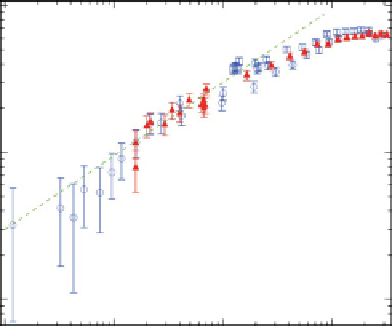Geoscience Reference
In-Depth Information
(a)
Boundary layer ratio,
P
(b)
0
1.61
3.22
4.82
6.43
8.04
7
10
8
7
6
5
4
3
2
6
5
4
1
8
3
7
6
5
4
3
2
2
1
0.1
8
0
1
2
3
4
5
0.01
0.1
1
10
Rotation rate Ω (rad/s)
Supercritical froude number,
F
s
Figure 1.22.
Experimental measurements of dimensionless integrated heat transport (excess Péclet number) attributable to baro-
clinic eddies in a rotating annulus experiment derived from data of
Read
[2003] and presented (a) as a function of
and
P
and
(b) as a function of “supercritical” Froude number
F
s
(see text). Pe
xs
may be compared with the nonrotating total Péclet number
of around 10. Open circles are for
m
= 2 flows, filled triangles for
m
= 3, and open squares for
m
= 4 dominated flows. For color
detail, please see color plate section.
(at least in the experiments discussed by
Read
[2003]) of
around 6-7 at around
= 3 rad/s, after which Pe
xs
levels
off and may even start to decrease at the highest values
of
. This would appear to indicate that eddy-induced
heat transport tends to saturate at a finite level once the
instability becomes fully supercritical. Such an effect is
also evident in Figure 1.22b, which shows the same data
plotted against a measure of baroclinic supercriticality in
terms of
used to investigate quantitatively the validity of some of
the assumptions underlying various approaches to eddy
parameterization.
Read
[2003],
Pérez
[2006] and
Pérez
et al.
[2010] have investigated various aspects of the dif-
fusive approach to parameterizing heat transport in the
context of the rotating annulus by making use of diagnos-
tics of DNS model simulations of baroclinic annulus wave
flows over a wide range of conditions with reference to the
experimental measurements reported by
Read
[2003]. As
mentioned above in the first part of this section, the notion
that radial eddy heat flux should act down gradient with
respect to its zonal mean field is implicit in various pro-
posed parameterizations of eddy transport in the oceans
and atmosphere, although this is notoriously difficult to
deduce directly from theory or to verify in observations.
However, many of these formulations are derived from
simplified analyses based on quasi-geostrophic theory, so
they should apply equally well to both geophysical situa-
tions and in the laboratory, at least within a limited range
of parameters where quasi-geostrophy is reasonably valid.
Despite the well-established applicability of quasi-
geostrophy to laboratory systems such as the rotating
annulus [e.g.,
Williams et al.
, 2010], however, there has
been surprisingly little work done to investigate the
parameterization of heat transfer in stably stratified flow
in the laboratory and thereby to test the kinds of schemes
proposed for use in models of oceans and atmospheres. In
particular,
Pérez et al.
[2010] examined the extent to which
baroclinic eddy fluxes of heat or vorticity (potential or
F
s
. This clearly indicates an initial dependence of
Pe
xs
close to
1
/
2
s
O
(1) (indicated by the dashed
line in Figure 1.22b) but with a weaker dependence as
F
s
increases further. However, measurements penetrating
further into the supercritical (irregular) regime would be
desirable to confirm this saturation effect. The numerical
simulations of
Pérez
[2006]; and
Pérez et al.
[2010] would
seem to suggest that Pe
xs
may continue to increase weakly
as
F
for
F
s
is increased toward 10 (so the axisymmetric share of
heat transport becomes relatively small), but these high
simulations probably had insufficient resolution to handle
the increasingly turbulent wave flows at these high rotation
rates, so the values of
P
may not represent accurately the
heat transport of the real fluid system.
N
1.4.4. Testing Local Closures for Baroclinic
Eddy Transport
Direct numerical simulations (DNSs), as discussed by
Pérez et al.
[2010], enable various diagnostics of com-
plex baroclinic wave flows to be obtained that can be

















